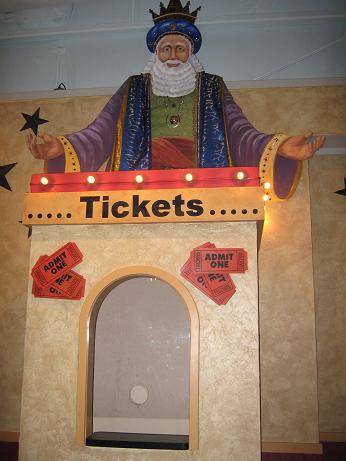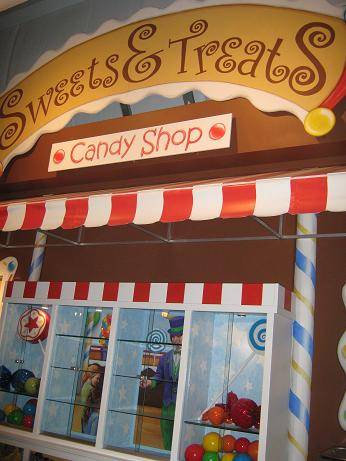
Way out on the southwest outskirts of town, in the middle of farm fields ripe for upscale development, an immense structure has arisen that has attracted the attention of quite a few folks around here, most notably those folks with young children. Why? Because within it’s cavernous walls lies a veritable “neverland”-esque indoor play-space that is free, open to the public, and conveniently located just off the new Windsor Road highway exit.
When parents enter this space for the first time, they tell me they are amazed at the state-of-the-art walking track, playground, and picnic area. Indeed, the entire facility is brightly decorated to resemble something along the lines of Disney’s main street, complete with a real-life fire engine and fluffy clouds dangling from the ceiling.
No, this isn’t a new Chucky Cheese big-box restaurant or a creatively-inspired park district facility or even the controversial new YMCA building. This is the First Christian Church, an institution “committed to glorifying God by helping people surrender to Jesus and become more like Him.”
The First Christian Church’s website gives the following history and description of this facility:
The first part of the Family Life Center (Phase II) was completed in February 2007. This building is home to the Oasis Student Center for Jr. High and [high school] ministries. It includes a large space for worship, as well as breakout rooms, booths, and a snack bar complete with a soda fountain. In addition, it includes a mezzanine level with video and arcade games, ping pong, foosball, pool, and air hockey. The Family Life Center also provides space for the elementary children’s programs. The space includes a large room for group worship, and several classrooms to breakup into age-specific groups.
The highlight of the Family Center is the indoor playground and the walking track which surrounds it. The playground and track are currently open for public use, as well as used by FCC families. The setting provides unique opportunities to introduce the community to FCC and bring them to the FCC Campus.
Certainly, judged by the number of birthday parties my kids are attending there, the community has not only been introduced to FCC, but is beginning to flock there in droves. Seniors, moms pushing strollers, and joggers are driving out for their daily workouts, playgroups and playdates are jumping around on the equipment, spinning on the merry-go-round and running to and from the family-friendly restrooms.
Evidently, the church has, not surprisingly, experienced a surge of families attending services. Parents check-in their children for the populous Sunday school via computer kiosks, and the kids enter their grade (and sometime gender) appropriate rooms behind brightly painted walls depicting toy or candy stores, cinemas, garden tea shops, and the like.
It certainly seems like the leadership of the First Christian Church (all 14 of them, elders and pastors alike, are men, incidentally) has figured it all out: how to reach out to the community, attract new worshippers, and get a congregation excited about being in church.
Yet, when I stand in the doorway of this amazing facility, something isn’t quite right, something in the way such an enticing environment might mask the real reasons humans seek out spiritual meaning. Or perhaps I think about how much money such a facility must have cost and how a faith-based organization might have spent the money otherwise to really make a difference for those less fortunate. Or perhaps it’s the Sunday school rooms painted like candy shops, baiting children into religious life like the kidnapper in Chitty Chitty Bang Bang.
I’m not sure really sure where to begin to really pin down my reservations, but I do know that such a consumerist approach to religious recruitment is an affront to my conviction that people have a free will and can make reasonable choices on their own, without the carrot dangling in front of them all the time. And believe me, with its coffee shop, arcade games, and pop music, this church is one big carrot.
Many in the world of religion have studied the megachurch phenomenon. There are many books available on the topic as well as research done by the Hartford Institute for Religion Research. But the critics and proponents agree on one thing: Megachurches are a defining trend in our society today. Researcher Jennifer Coswell noted:
While small church buildings with ‘For Sale’ signs are increasingly becoming a part of the local landscape, megachurches, with their modern architecture and mammoth campuses, are starting to pop up across the country.
Megachurches … offer food courts, gymnasiums, pools, rock-climbing walls, and movie theaters. By offering so many services, these churches have created a one-stop-shop atmosphere. Parents can drop off their children for weekly youth activities, grab a mocha, exercise, and fix their marriage, all in one place. This system seems to take the mysticism out of spirituality by commodifying the religious experience in such a way as to cater to mainstream culture. …
Another researcher, Alan Wolfe, a professor of political science at Boston College, describes the megachurch phenomenon in his book The Transformation of American Religion: How We Actually Live Our Faith. He writes, “American faith has met American culture — and American culture has triumphed.”
Perhaps this is why I’m tentative to embrace what is becoming an unofficial winter community center for our area, in spite of its positive spins. There is simply something about the “selling” of religious experience that is unsettling. When churches become more like big businesses and ministers more like CEOs, doing market studies, finding revenue for expansions, teasing out consumers by offering them a simulacrum (or a superficial copy) of community, then you can count me out. Perhaps there is true community behind the facades of FCC’s idealized Main Street, and I’d be glad if others do indeed find that togetherness, but the means to achieve this end are for me, not altogether holy.








